Juror: Michael Dunbar
Curator: Hank T. Foreman
Curator’s statement
The Catherine J. Smith Gallery and An Appalachian Summer Festival are proud to present the 13th Rosen Outdoor Sculpture Competition & Exhibition. The diversity of materials, techniques, and content makes this an exciting and challenging exhibition. Through the years, the Rosen program has sought to make an impact mainly on two groups of people.
First, the exhibition’s goal is to bring sculpture into the lives of as many viewers as possible. With tours, special presentations, and materials made available to any classroom or group upon request, the Rosen program has broadened its outreach, and has afforded many new people with the opportunity to investigate outdoor sculpture. Certainly for those of us who circulate around the works, the program brings public art to us every day.
Second, the competition and exhibition seeks to positively impact the lives of artists by creating a premier venue for exhibition, providing documentation materials like catalogues, and offering awards for outstanding work. From its conception, the program has met the exhibition needs of sculptors. Over the years, there seem to be less exhibition opportunities for artists creating large-scale outdoor work, and the Rosen program was designed to create just such an opportunity. Each year the exhibition catalogue becomes more focused, informative, and beautiful. It is easy to understand how important the exhibition catalogue is to the viewer, but an overlooked importance is its role in the life of the artists. The exhibition catalogue is a working tool; it provides the artists with materials to present to prospective galleries and patrons. The catalogue can also impress upon people the strength of a public art program. Each artist exhibited on campus receives an honorarium to help meet the challenges of everyday life as an artist. Every year the program awards the Martin and Doris Rosen Award, and this large prize is designed to help the winner move their work/career to the next level. With this prize money, artists have bought much needed studio equipment, ordered materials for new work, taken research trips, and even helped finance better working facilities.
In recent years, we have worked hard to strengthen the program so that it better meets the needs of the above mentioned groups. We have increased the scope of the catalogue to include statements from the artists and juror. Also, we have added a new dimension to the catalogue by the use of color images. We have increased the amount of images in the catalogue to offer a more comprehensive view of each sculpture, and we have developed a strong website. This year’s catalogue contains a new feature; the works represented in the exhibition are listed in numerical order by their site assignment. This makes it much easier to refer to the catalogue when touring the works. Last year we introduced the site specific sculpture category and featured two such works in the exhibition. This year we continue this expansion of the program and also feature two site specific works.
The Rosen Outdoor Sculpture Competition and Exhibition has become an integral part of the Appalachian State University experience. Each year as the previous installation comes down and the new works begin going up, we hear the responses of people passing by. “Oh, I really liked that one, I hate to see it go” or “Look at that, it’s neat and strange, but neat.” These casual responses remind us just how many people come in contact with these works over the years, and, more importantly, that they are involved in thinking about them. We invite you to explore, consider and enjoy these works.
Hank T. Foreman, Curator
Juror’s statement
I am honored to have had the opportunity to serve as the juror for the 13th Rosen Outdoor Sculpture Competition and Exhibition. Thanks to Hank Foreman for inviting me to view this year’s entries and pass judgment. Thanks also to Kim Johnson for all her efforts arranging for my visit.
Through the ongoing support of the Rosen family, Appalachian State University has established a rich tradition of exhibiting three-dimensional art work in the most pleasant of settings. Nestled against the backdrop of the Blue Ridge Mountains, this show has become an important venue for contemporary sculptors. The response to the call for entries this year was exceptional with artists responding in both number and quality. Although this response makes the juror’s job that much more challenging, it also results in a very strong exhibition.
My role as the juror is to provide a fresh perspective on the exhibit and the artists who enter. Initially, my concerns address basic issues of presence, scale, execution, visual impact, concept, safety, durability, and the collective appearance of the exhibit. The more difficult challenge is to identify from the exhibit the one work of art to be awarded special recognition. In this case I chose to select a work of art that addressed this unique setting, was sensitive to the heritage of the community and made a powerful visual statement.
This year’s Martin and Doris Rosen Award has been presented to Joe Thompson for his site specific sculpture Wisdom-Knowledge. Responding to the visual references of the surrounding area, this year’s winner keyed into the distinct green metal roof of the campus architecture to culminate a formalized containment of rocks, farm implements, household relics, and a school desk. These are all assembled in an exposed stratification that calls to mind the geology, population, occupation, and institution previously and currently associated with the site.
I have also requested a Juror’s Award of Special Merit be awarded to Judy Strahota for her construction titled Support Where Most Needed. Aside from the obvious parody of scale and subject, both the construction and attention to detail in this piece are exemplary.
Congratulations to Joe Thompson, Judy Strahota, and all the artists of the 13th Rosen Outdoor Sculpture Competition and Exhibition. It has been a pleasure to experience this exhibit and setting as a juror.
-Michael Dunbar
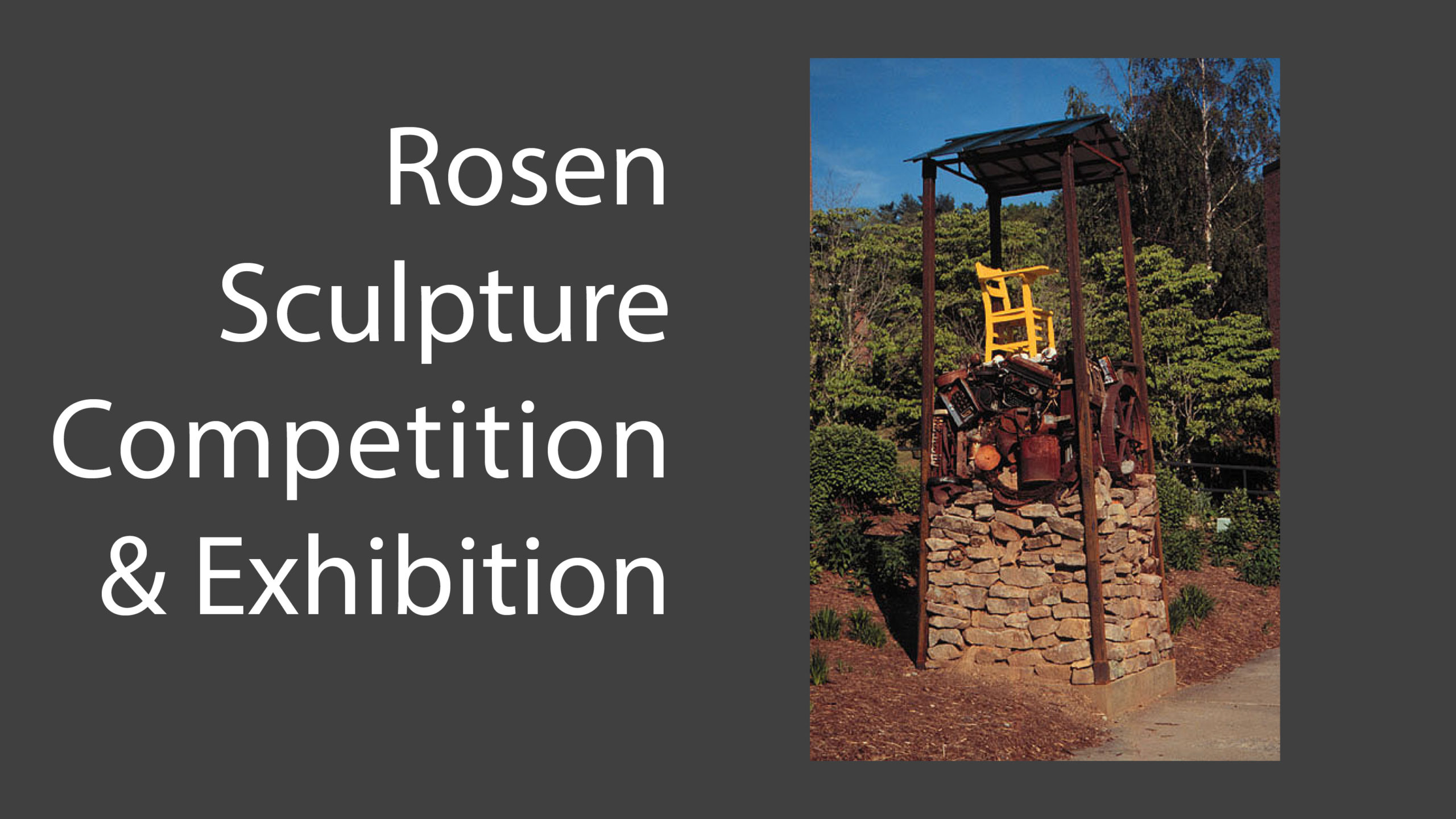
Joseph Thompson, Wisdom-Knowledge. 1999 / 13th Rosen Sculpture Competition Winner.
Sculptures
-
Wisdom – Knowledge1st Place
-
Support Where Most NeededJuror's Award of Special Merit
Wisdom – Knowledge
Joseph Thompson
Athens, Georgia
Steel, Stone, and Found Objects. 14′ x 5′ x 5′
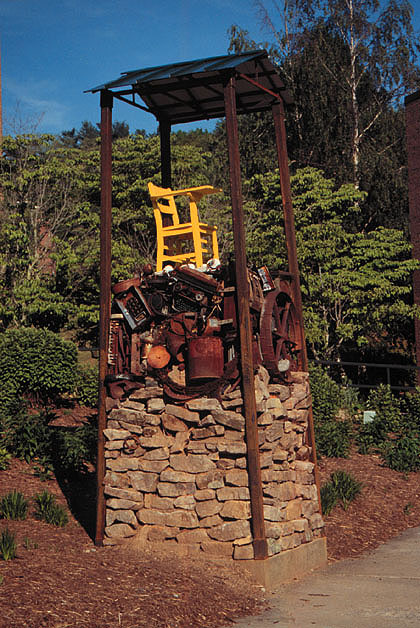
Artist statement
In this work, I am dealing with Boone as the site of a collision of cultures; an old Appalachian and essentially agrarian culture and a new culture of education and technology.
The form of the work in general is intended to capitalize on both the visual language the architecture which surrounds the sculpture and the idea of archeological strata as an indication of human activity on a specific site.
The text welded into each corner-post further delineates this concept of Boone as a point of contact between cultures, and asks the viewer to question what is gained and what is lost in terms of cultural values, esthetics, and identity.
Juror’s Comments
Responding to the visual references of the surrounding area, this year’s winner keyed into the distinct green metal roof of the campus architecture to culminate a formalized containment of rocks, farm implements, household relics, and a school desk. These are all assembled in an exposed stratification that calls to mind the geology, population, occupation, and institution previously and currently associated with the site.
Support Where Most Needed
Judy Strahota
Chicago, Illinois
Wood, Steel, and Firehose. 13′ x 13′ x 11′
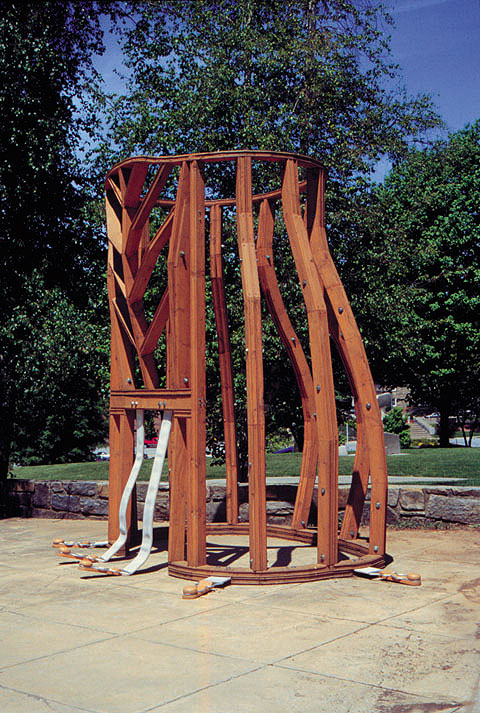
Artist statement
I have always been inclined to build and do rather than read and write. Ultimately, this influenced my becoming a carpenter as a means of financing art making. Excelling in a non-traditional field has been a catalyst for my body of work made from wood. I use both new and used construction-grade lumber to employ traditional framing methods of housing construction which I re-work to create curvaceous forms of specific feminine iconography. Contemplation of gender differences, the traditions of domestic histories, and my personal experiences have greatly influenced my subject matter. Although my work stems from personal investigation, I endeavor towards a framework that allows others to filter the work through their own experience, thus inspiring a broader dialog about “self” and understanding others. While I seek a compatible mix of form and content, I approach my work from a viewpoint that is both aesthetic and feminist. I am inspired by potential and serendipity, and I believe the foundation of my art making lies in the combined strength of my building skills, command of the creative process, and powerful intuitive response. In challenging these skills I often find myself serving as a role model. My objectives include affirming women’s experiences through the framework of my own and creating work that stimulates and moves women to the forefront of both sculptural and functional construction.
Cathedral
Ann Melanie
Greenville, North Carolina
Steel. 4′ x 6′ 6″ x 10′
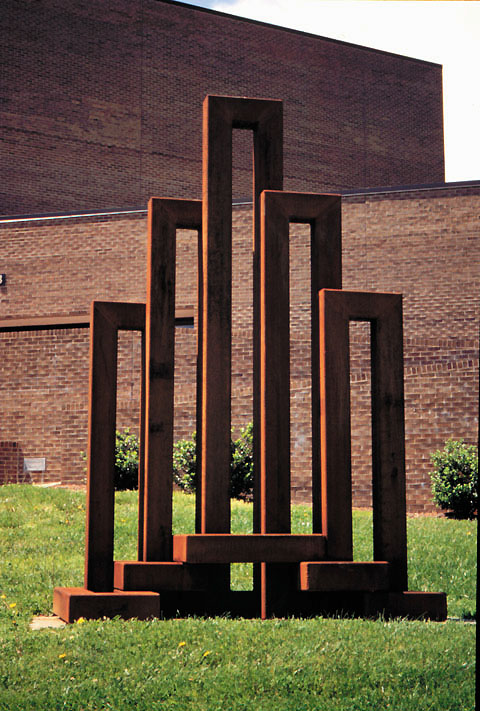
Artist statement
The rectilinear forms which make up the largest part of my work represent windows and doors. The windows look from my world into yours but keep us apart and doors allow passage through. These architectural references in my work are its conceptual base, and are founded in the development of both my private and public persona. Windows and doors are not literal images, but act as a symbolic reference to ideas, images, and emotions. Although my use of symbol is highly abstracted and not of a universal nature, the work can be understood on a purely formal level. The work is simple in its form and complex in its construction. My work is the sum of my life experiences; it has no specific meaning and it means everything.
About the artist
Ann Melanie, was born in Moses Lake Washington, her family is from Skowhegan Maine; Melanie received her MFA in sculpture in 1995 from East Carolina University. Her work includes gallery-scale and large public sculptures. Melanie uses simple forms that lend themselves to casting, carving and fabrication. She has shown throughout the United States in many venues, including the Rosen Outdoor Sculpture Competition, and The Pyramid Sculpture Park in Hamilton, Ohio. Her work is part of the permanent collection of the East Carolina Sculpture Park. She currently lives in Greenville, North Carolina where she is the academic advisor for the School of Art and Design at East Carolina University.
Channel Vessel
Adam Curtis
Jamestown, North Carolina
Carbon Steel. 10′ 6″ x 10′ 6″ x 13′
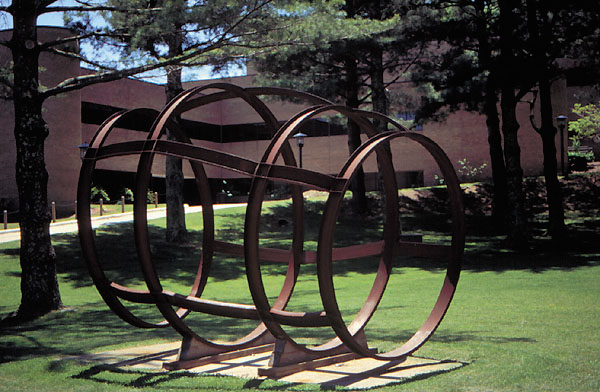
Artist statement
The ideas with which I am currently concerned involve objects that have interior spaces. The sculptures invite the viewer to enter and become an active participant. These works function well in a public context because they work as formal sculpture and yet are interactive. They address contemporary issues of site specificity and viewer engagement.
By opening the side or end of an abstract sculpture and creating an interior space with a new set of spatial experiences, the viewer gains a new perspective. Establishing architectural space with a form not found in architecture is one of my goals.
The sculpture aims to attract the viewer from a distance – it is large, unusual, eye-catching, suggesting a container or a head, a barrel or a hull frame, an unfinished building or ship and also something unseen before. The pieces are inspired, in part, by civil engineering. But as the viewer zeroes in on a piece, it reveals less of itself because of its scale and openness; the landscape around it is meant to be seen through the piece, not obscured.
Fool’s Ship
Tim Kussow
East Hartford, Connecticut
Steel and stones. 12′ x 9′ x 2′
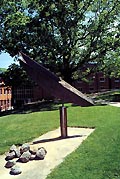
Artist statement
Fool’s Ship, the object/finished product, was brought about by a sculptural performance of the same name. Simply put – the player/fool/myself is going through a labor-intensive, materials handling frenzy – putting myself out there and cracking the rocks manually. This fervor in finishing the piece – Fool’s Ship – in turn separates it (the object) from the artist. I, the fool, am controlling my own destiny, filling the ship with meaningless things – like the ballast in a ship. This skewed ship – a cornucopia of holding – encapsulates and mimics life in the way it contrasts the light/heavy tension that is always around us. The object combines form and idea – process and product. It is not in my nature to put everything out there and be vulnerable, as in an extroverted performance. Risk? Maybe. But I usually laugh at risk because it is too trivial and relative. This is a stretch for myself – breaking rocks – but it directly parallels the struggle, and the jumping through hoops I must do in the two systems that I live: Academia and Art. Obsession and passion go hand in hand when I am fully immersed in these systems, but remember; it is not enough to be genuine – to just make art – Art has to have meaning as does the “pile of rocks.”
Gethsemane
Shawn Morin
Bowling Green, Ohio
Limestone. 7′ 3″ x 8′ x 7′ 3″
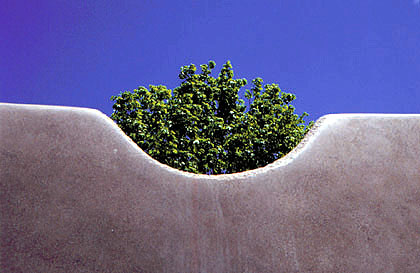
Artist statement
Often times it is, in part, through our creative spirit that we are touched by and connected to our Creator and His Spirit. And while no artist or work of art can accurately or even adequately address the dimensions of the spiritual world, it is my hope that this work can somehow begin to promote and nurture the reality that in our life’s journey each of us inevitably must choose to either pass by or through Gethsemane.
About the artist
Just prior to receiving his B.F.A. in sculpture, Shawn Morin asked one of the professors he admired most: “So, do you think I have what it takes to be an artist”? Without missing a beat or bating an eye, he smiled and said, “NO, you don’t.” A few months later Morin entered the M.F.A. program as the University of Georgia in Athens as an “irregular undergrad,” which, when translated means, “we’ll let you enroll on a trial basis, take your money for a year and see what happens”. After successfully completing his first year in Athens, he was fully accepted into the masters program and granted an assistantship. However, a few weeks later he received a letter from the university stating that his assistantship was being revoked and that he was being asked to leave the university due to low GRE test scores. Nevertheless, Morin completed his M.F.A. the following year and at age 26 began his teaching career. Recently, he chaired a committee that abolished the GRE requirement for M.F.A. applicants at BGSU. The very next year, the number of graduate applications in the School of Art more than doubled.
Morin has just completed his nineteenth year as Head of the Sculpture Program at Bowling Green State University in Ohio. He has participated in more than 140 exhibitions throughout the country, and his work can be seen in 15 permanent public collections, and is included in over 35 private collections. Since 1992, nearly every one of Morin’s own graduate students are currently teaching in high schools, colleges, and universities around the country.
For more information, visit shawnmorinsculpture.com.
Jelly Belly
Greg Moring
Youngstown, Ohio
Steel. 14′ x 11′ x 10′
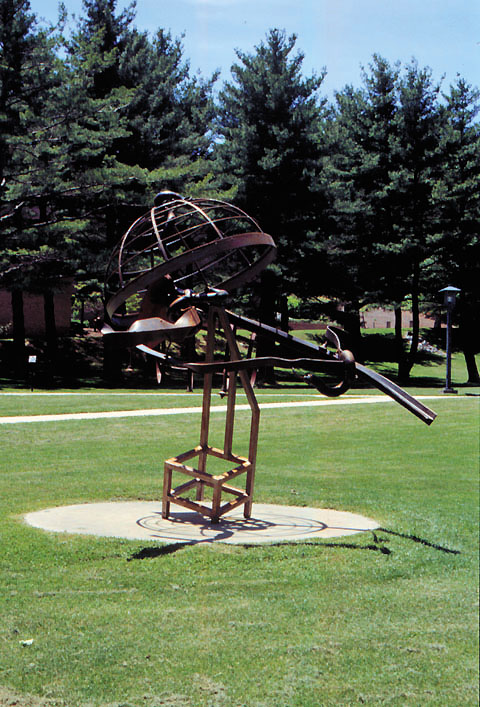
Artist statement
I have been working with monumental sculptural forms for many years. The integration of the sculptural object into a public space has been a central goal of my research. This process of integration begins with the idea that the sculpture must be responsive to its communal function and responsibility. It must not be so aggressive as to alienate its collective viewers, but be truly expressive and meaningful to the public at large. In fact, my work acquires many of its social meanings directly from its communal environment. The great value of public sculpture is that it can be considered a reflection of our contemporary society.
Leroy’s Night Crawler
Suzanne Fausette
West Hartford, Connecticut
Mild Steel. 176′
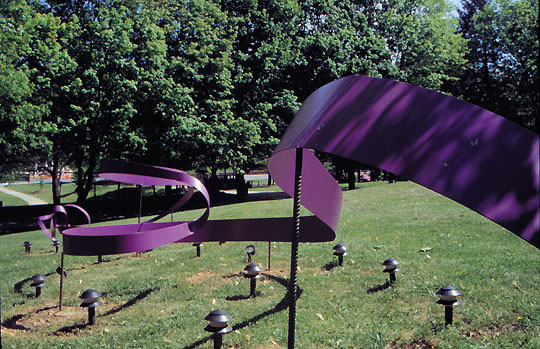
Artist statement
My outdoor linear works grew from a childhood need to escape the threats and neglect of a hostile environment. With longing and imagination, I would project myself out of my body, out of my situation, and into the world. From that painful time I retained the beautiful images gained while traveling the contours of a building or landscape, exploring all the possible patterns of movement.
As a sculptor my intention is to foster an interaction among the viewer, the sculpture, and the environment. After discovering the character of a place, I set about illustrating the inherent movements that I have learned to see and feel. The sculpture reacts to the contours and energy of the site. The viewer is invited to follow the movements of the sculpture either visually, physically, or both therefore connecting them in a new way to what may have previously been dismissed as just a hill.
Visiting beautiful North Carolina for the first time I began by asking people, “What is the nature of the mountains of North Carolina?” I was told about the wind, the drifting snow, and the rivers. Then I asked Leroy, a grounds keeper at ASU what he thought of my work in progress. He scratched his head and replied in a southern accent, “Well I’d sure hate to see the look on the robin’s face that swooped down to try and pick up this here night crawler!” He then told me all about the night crawlers and good fishing of North Carolina. This was the instinctive and honest response that I had been looking for!
Process
Rogelio Tijerina
Bayview, Texas
Cast bronze and found objects. 8′ x 8′ x 30′
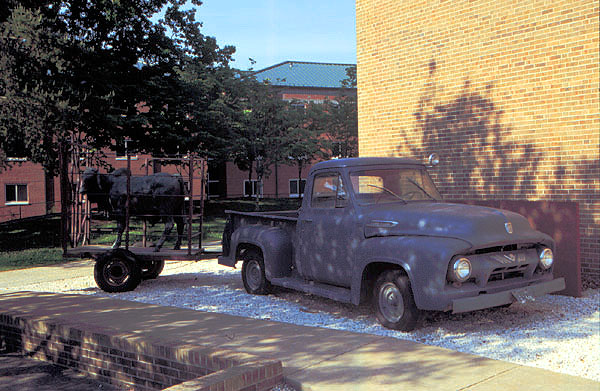
Temple VII
Fr Austin Collins
Notre Dame, Indiana
Steel. 14′ x 4′ 6″ x 5′
Artist statement
In my recent work, The Temple Series, I hope to invoke in the viewer a sense of sacred space, of retreating, of reflection. By constructing a space with abstract geometric steel forms, referencing architecture, games, and toys, Temple VII generates a bodily response from both structural and compositional.
About the artist
Professor Austin Collins is a sculptor known for his large-scale metal work that draws on and extends the Modernist tradition. His work has been featured in 137 exhibitions and is included in over 57 public and private collections. He has also given 35 public lectures on his work at various institutions across the country.
Collins’s area of practice includes public art, large outdoor sculpture, installation art and liturgical art. The theme of his creative work often deals with political and social issues.
Collins has exhibitions at Northwestern University, University of Tennessee, University of Alabama, University of California and the University Virginia. He currently has work on view at: University of Alabama, City of Huntsville, AL Sacred Heart University Fairfield, CT, University of Toledo, Toledo, OH, Indiana University, South Bend, IN, City of Port Huron, MI, East Carolina University, Greenville, NC. Fernwood Botanical Garden & Nature Preserve, Niles, MI, Fredrik Meijer Gardens & Sculpture Park, Grand Rapids, MI and Bowling Green State University, Bowling Green, OH. His work has been reviewed and written about in publications such as Sculpture Magazine, The Chicago Sun-Times, New City Chicago, The Detroit News, The Indianapolis Star and Dialogue.
Collins Studied art at the University of California at Berkeley and received a M.F.A. in sculpture from Claremont Graduate University. Collins is currently a professor of sculpture at the University of Notre Dame, a position he has held for the past 29 years.
For more information, visit www3.nd.edu/~acollins.
A Tribute to Sherry Edwards
This past year, Appalachian State University experienced the loss of one of its longtime educators and artists. The passing of Sherry Edwards is felt not only within the Art Department, but throughout the entire University. During her years at the University, Sherry influenced the lives of students, staff and faculty. Her jovial manner, and unwillingness to accept that there was anything she (or others) couldn’t do were her hallmark. These traits led her to great accomplishments and earned her the respect of those around her. It is largely due to Sherry that there is a Rosen Outdoor Sculpture Competition and Exhibition. Through her belief that such a program would greatly benefit the campus and the artists, Sherry drew support for the program we enjoy today. We join with the entire Appalachian family in expressing our loss, but, more importantly, in joyfully remembering the lives touched by this artist and friend.
Hank T. Foreman
Director & Chief Curator
Turchin Center for the Visual Arts
About the curator
Hank Foreman serves as Assistant Vice Chancellor of Arts and Cultural Affairs as well as Director and Chief Curator of the Turchin Center for the Visual Arts for Appalachian State University. He obtained his M.A. in Art Education from Appalachian, having completed undergraduate studies at the University of North Carolina at Charlotte, with a concentration in Painting and Sculpture. His duties include the administrative responsibilities for An Appalachian Summer Festival, the Performing Arts Series, Farthing Auditorium and the Turchin Center for the Visual Arts.
During his tenure at Appalachian State, Foreman has taken part in the organization of numerous exhibitions, including the associated lectures, symposia, and publications. He has worked closely with the university’s Department of Art, and a wide variety of other campus and community groups, to make gallery resources available to all. One of his earliest exhibitions at Appalachian, Views From Ground Level: Art and Ecology in the Late Nineties, brought internationally acclaimed artists, historians, and critics to the campus and received national attention.
Foreman is also an exhibiting studio artist, and participates in regional and national conferences as a presenter and panelist.
A Special Thanks from the Curator
On behalf of An Appalachian Summer Festival, the Office of Cultural Affairs, and the Catherine J. Smith Gallery, I wish to thank all of the artists who participated in this year’s competition and congratulate those chosen for the exhibition. Each year the Rosen Outdoor Sculpture Competition and Exhibition is made possible by the generous support of Martin and Doris Rosen. The Rosens are tireless supporters of the arts, and over the years have given so much of themselves to ensure that the arts became a more integral part of our community. Their excitement and dedication serves as both inspiration and role model. I would like to thank our juror, Michael Dunbar, for his dedication and professionalism during the completion of his difficult task. I wish to thank my colleagues in the Office of Cultural Affairs, my colleagues in the Art Department, and the students who participated in the installations. Special thanks to our designer – Mike Fanizza, photographer – Troy Tuttle, Assistant to the Gallery Director – Kim Johnson, the folks at Boone Crane, and Jerry Clemens and the staff of Clemens Welding.
A heartfelt thanks to Jim Bryan – Grounds Superintendent, and to Evan Rowe – Safety Officer. We also extend our thanks to the entire Grounds and Electrical Department of the Appalachian State University Physical Plant. Their cooperation and expertise continues to make our campus a beautiful venue for outdoor sculpture.
Hank T. Foreman
